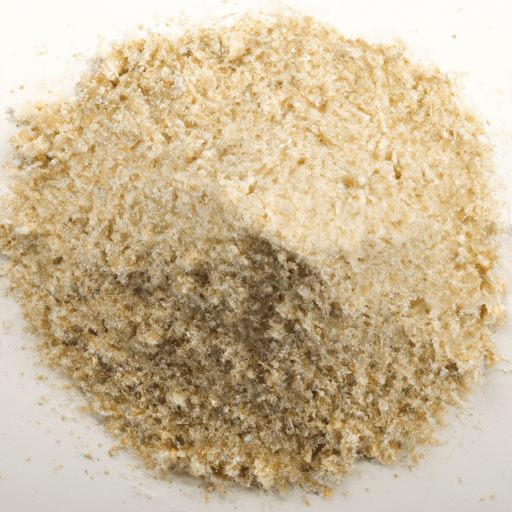Exploring the Versatility and Nutritional Value of Whole Wheat Bread Crumbs
When it comes to cooking, whole wheat bread crumbs are an incredibly useful ingredient to have on hand. They add a delightful crunch and flavor to a variety of dishes while providing several health benefits. In this blog post, we will dive into the world of whole wheat bread crumbs, uncovering their taste, common uses in cooking, nutritional value, and some interesting facts about their history. So, let’s get started!
1. Taste and Texture
Whole wheat bread crumbs have a slightly nutty and earthy flavor compared to their white bread counterparts. The hearty taste of whole wheat pairs well with savory ingredients and adds a satisfying depth to your dishes. As for texture, these crumbs have a coarse and crumbly consistency, ensuring that your finished dish has a delightful crunch.
2. Common Uses
a) Coating and Breading
One of the most common uses of whole wheat bread crumbs is for coating and breading various foods. Whether you want to add a crispy outer layer to chicken tenders, fish fillets, or vegetables, whole wheat bread crumbs are an excellent choice. Simply dip your chosen food in an egg wash, then coat it with these crumbs before baking or frying. The result is a golden and crunchy exterior that perfectly complements the tenderness inside.
b) Meatballs and Meatloaf
Whole wheat bread crumbs are essential in creating moist and tender meatballs and meatloaf. When mixed with ground meat, eggs, herbs, and spices, they help bind the ingredients together and contribute to a light and airy texture. Plus, the addition of whole wheat bread crumbs adds a touch of nuttiness, enhancing the overall flavor profile.
c) Casseroles and Stuffings
Do you enjoy indulging in hearty casseroles or making comforting holiday stuffings? Whole wheat bread crumbs make an excellent addition to these dishes too! They provide a satisfying crunch throughout the dish while absorbing any savory flavors they come into contact with. Whether you’re making a vegetable casserole or a delicious stuffing for Thanksgiving, whole wheat bread crumbs will elevate the texture and taste.
3. Nutritional Value
Whole wheat bread crumbs offer several nutritional benefits over their refined white bread counterparts. They are a great source of dietary fiber, which aids in digestion and helps maintain a feeling of fullness. Additionally, whole wheat bread crumbs are rich in vitamins and minerals, including phosphorus, magnesium, and B vitamins. These nutrients contribute to maintaining bone health, supporting muscle function, and promoting overall well-being.
4. Fun Facts about Whole Wheat Bread Crumbs
- Whole wheat bread crumbs have been used in culinary traditions for centuries. The ancient Greeks and Romans understood their value in adding texture and flavor to various dishes.
- Making your own whole wheat bread crumbs is a fantastic way to reduce food waste. Simply save your leftover whole wheat bread slices, allow them to dry out, and transform them into homemade crumbs.
- Whole wheat bread crumbs can be easily seasoned with herbs, spices, or grated cheese to add an extra layer of flavor to your dishes.
Now that you’re familiar with the versatility and nutritional value of whole wheat bread crumbs, it’s time to stock your pantry and incorporate them into your favorite recipes. From crispy coatings to moist meatballs and hearty stuffings, these crumbs are sure to become a staple in your kitchen. Enjoy the added texture, taste, and nutritional benefits on your culinary journey!
Origin: Whole wheat bread crumbs are made from whole wheat bread that is dried and then ground into small granules. The use of bread crumbs dates back to ancient times, and whole wheat bread crumbs have been a staple ingredient in many cuisines around the world.
Common Uses: Whole wheat bread crumbs are commonly used as a coating or topping in various dishes. They can be used to bread meats, fish, or vegetables before frying or baking, providing a crispy and flavorful crust. Whole wheat bread crumbs are also used in stuffings, as a binding agent in meatballs or meatloaf, and as a topping for casseroles or gratins. They add texture and can help absorb excess moisture in dishes.
Nutritional Benefits: Whole wheat bread crumbs offer several nutritional benefits. They are a good source of dietary fiber, which aids in digestion and can help maintain a healthy weight. Whole wheat bread crumbs also contain essential minerals such as calcium, iron, and magnesium, as well as B vitamins and antioxidants. Their whole grain content provides more nutrients compared to breadcrumbs made from refined white bread.
Unique Properties: Whole wheat bread crumbs have a coarser texture compared to their white bread counterparts, adding a delightful crunch and nutty flavor to dishes. They can be easily seasoned with herbs, spices, or grated cheese to enhance their taste. Whole wheat bread crumbs also have a longer shelf life than fresh bread, making them a convenient pantry staple.
Historical Significance: Bread crumbs have been used historically as a way to conserve and utilize every part of the bread. They were originally used in European cuisine as a way to extend the life of stale bread and to add flavor and texture to dishes. In Italian cuisine, bread crumbs, known as “pan grattato,” have a long-standing tradition in various recipes, including traditional meatballs and breaded dishes such as veal Milanese or eggplant Parmesan. Over time, whole wheat bread crumbs have gained popularity for their added nutritional benefits.




Use the share button below if you liked it.
It makes me smile, when I see it.